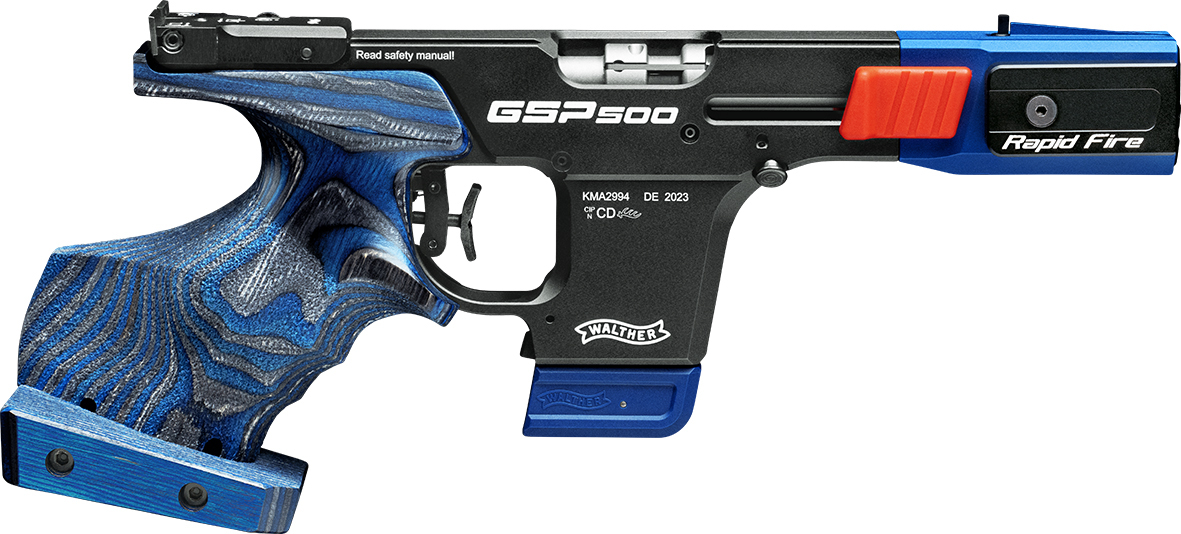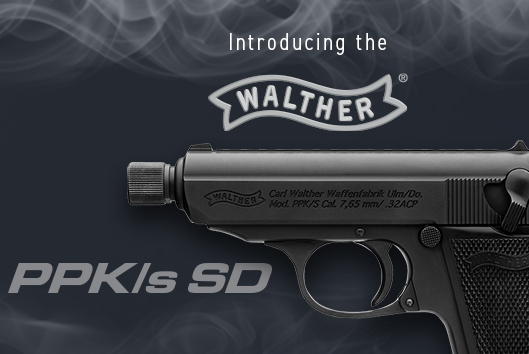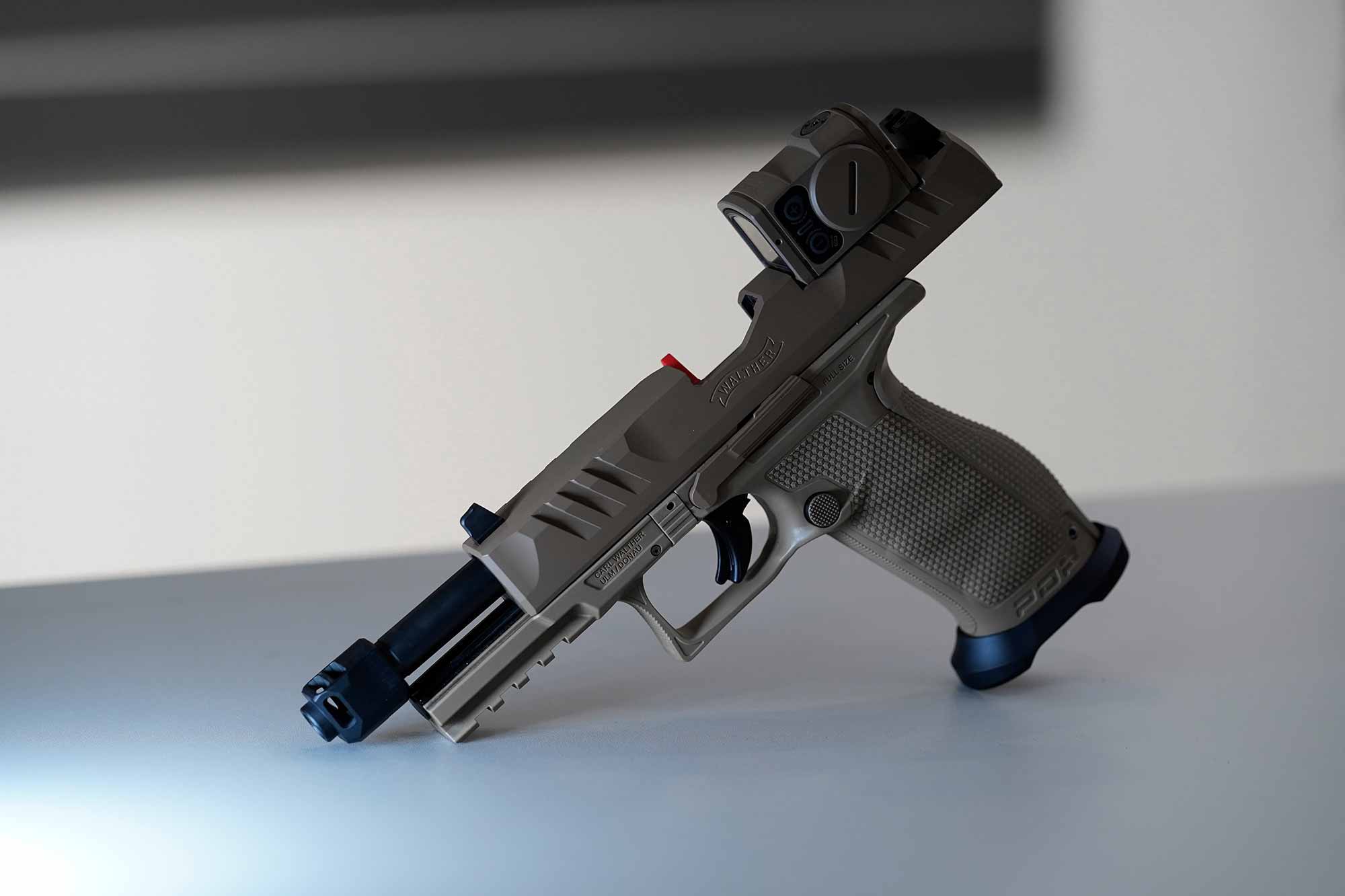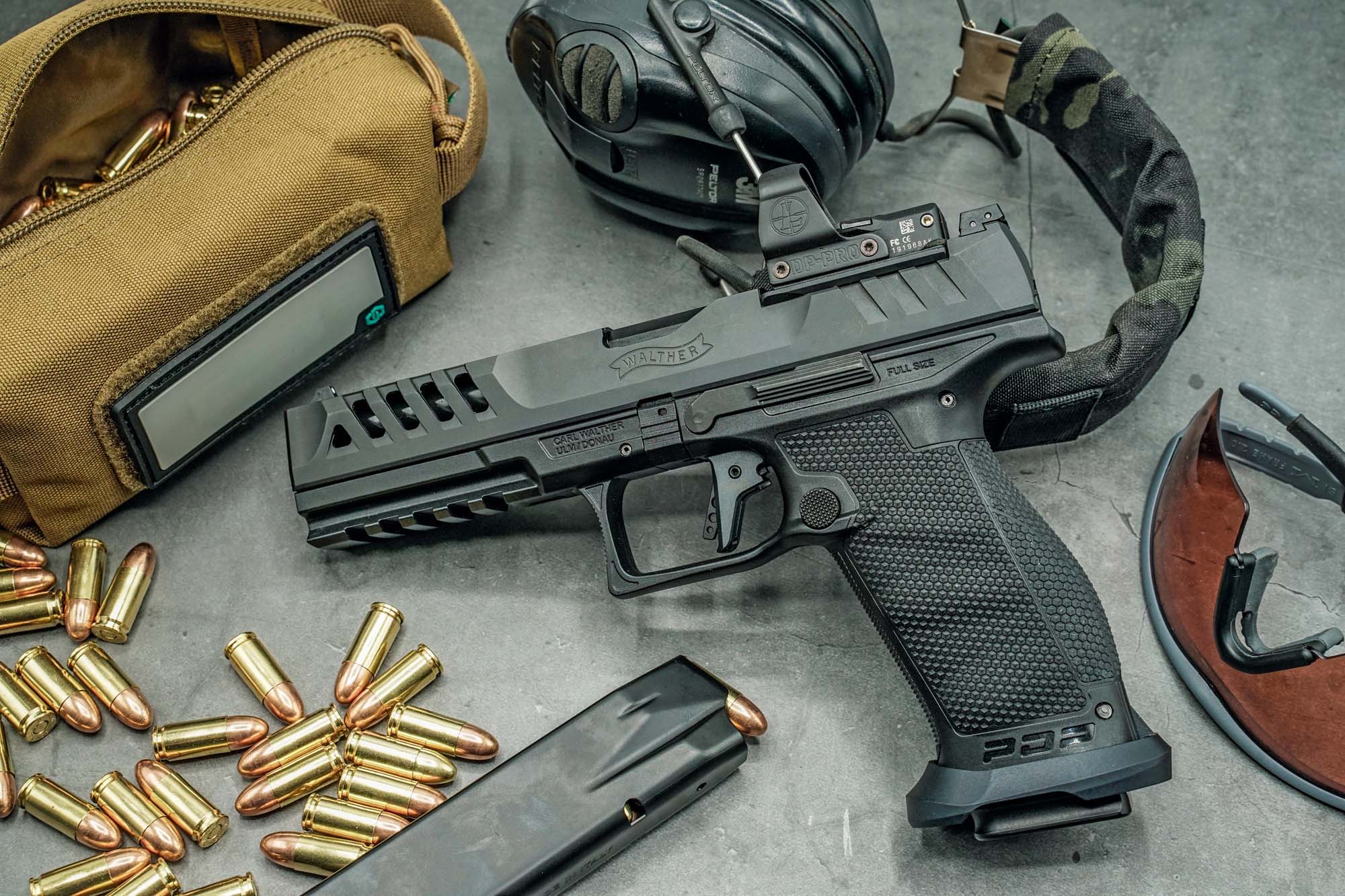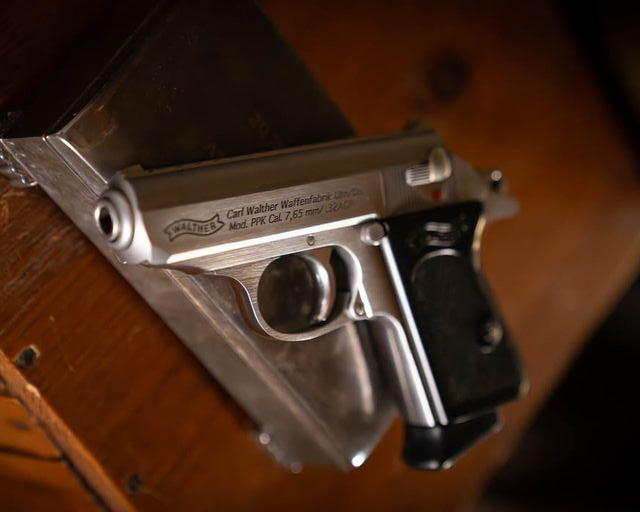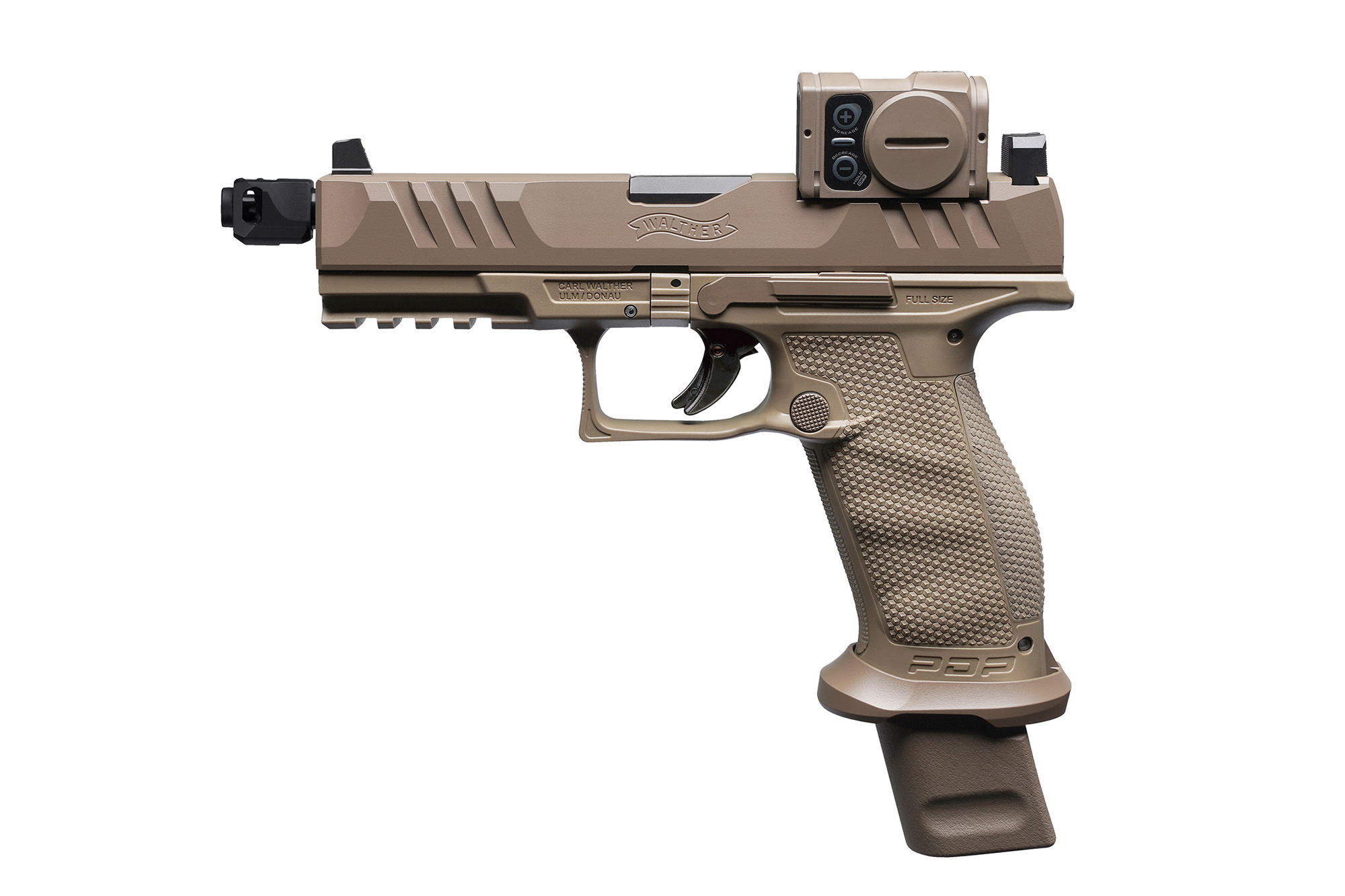Article also available in other languages

The modest name P99 turns out to be misleading: Walther didn’t bring the first of the new model P99 pistols onto the market in 1999, but somewhat earlier in 1996. Similarly to its predecessor – the P88 which hadn’t come out in 1988, but two years earlier. In the 90’s it was recognised that, although unusual at the time, the future lay in grips made out of plastic – Walther also realised this.
Glock had been going from one sales success to the next for several years. Rival competitors such as Heckler & Koch or Smith & Wesson had had their own models such as the USP and Sigma on the market for at least two years. With the P88 Walther had for the first time actually developed a sidearm with the popular Browning lock. But due to its solid basic construction and top quality the P 88 and its compact model were particularly expensive and didn’t really perform any better than the most established dural frame competitors of the time from Smith & Wesson, SIG Sauer or Beretta.
Anti-Stress Trigger
In 1996 the Walther P99 combined some of the features of its direct competitors who were also using Polymer: Just like the Glock pistols the P99 also uses a hammerless firing pin lock. The ambidextrous magazine release lever behind the trigger similarly first turned up in the P 7 M8 from Heckler & Koch and has since been integrated by the manufacturer into every new pistol model. However with his trigger Walther wasn’t guided by Glock’s partially pre-cocked Safe Action System, but by the proven and at that time well-established Double / Single Action System. With this system only the first shot is fired when fully uncocked.
However from today’s perspective the Walther P 99 “Anti Stress Trigger” (AS) is something of a curiosity. In contrast to traditional DA/SA triggers the trigger blade practically returns to the DA starting position after every shot despite the main spring now being cocked, as long as this is not prevented by the trigger finger. This overly long SA trigger travel should reduce the danger of “accidentally” firing the cocked P99 AS by briefly nudging the trigger blade even though the arm is cocked.
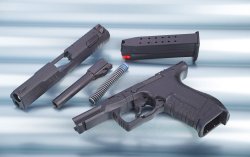
The second feature of the AS trigger is the extremely short reset distance for the next shot: for renewed firing readiness a reset of about 3 millimetres is sufficient with this trigger. Over the last few years this extremely short reset has become one of the particularly highlighted assets of a variety of pistols. But in the 1990’s there was barely any discussion of the short reset although the Walther P99 was already equipped with it and older versions such as the third generation DA/SA fully metal pistols from Smith & Wesson were too. To ensure against walking around with a cocked sidearm after chambering a round, Walther integrated a decocker on the top of the pistol in the lock. A small inspection hole in the retaining plate of the firing pin indicates the status of the striker. The reddened end of the firing pin sticks out visibly if the system is cocked.
With the P99 Walther introduced for the first time a detail which today seems indispensable for full price polymer pistols: interchangeable backstraps in different sizes. From today’s perspective there is nothing exciting and new about the locking principle itself. Like most modern large caliber pistols the P99 is equipped with an improved Browning lock with which the barrel is locked directly at the ejection point. The slide is guided on tracks moulded into the frame, the recoil spring can be removed as a completely encapsulated entity when disassembling the arm.
Alongside the classic P99 AS Walther brought out further models, although since then the manufacture of these has been partially discontinued again. This applies to the “DAO” line with a purely double action trigger and the “Quick Action” line with its permanently partially cocked trigger. Also their compact “C” versions are no longer available, however the regular P99c with Anti Stress Trigger is. Walther manufactures the compact versions with a 9mm Luger and .40 S & W.
Until now the P 99 AS was anything other than a sweeping success on the governmental agency market.
Generational Conflict
Walther’s individual manufacturing periods cannot be so clearly defined as for Glock or Smith & Wesson DA pistols. However a Walther P99 AS from 1996 does have differences to the P99 AS from current production – the modifications were implemented over a longer period of time, without a new model designation being made.
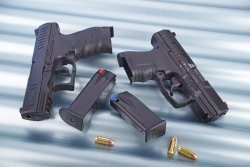
In 2004 and 2005 changes took place which particularly increased ergonomics and operability. The frame lost its unpopular, downward contoured horn-handle. The hump on the inside of the trigger guard was also dropped. It was actually meant to prevent the finger from inadvertently being caught under the trigger guard, but in fact it was only an irritation. The idiosyncratic mounting rail at the front of the frame made way for a “real” Picatinny-Rail.
Instead of the "combat nose" on the trigger guard, a guard which is rounded to the front with roughly diagonal grooves was decided upon. The magazine lever did remain in the trigger guard, but the touch surface which has been greatly lengthened at the front now extends as far as the trigger. And as the whole world now demands ambidextrous operability Walther fitted the P99 with a slide stop lever on the right side of the frame. Its touch surface was also clearly lengthened and its shape modified so that it can easily be depressed and lifted.
Alterations have also been made to the slide: at the back the gripping surface of the grooves has been greatly increased, as has the groove pattern of the serration slide itself. Normally the P99s which are currently sold in Germany have sights made out of steel. On the older versions they were made out of plastic.
For official use only: Walther P 99 Q
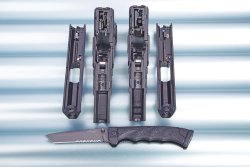
In order to bring the Walther P99 up to the newest standards desired by the German police, the manufacturer launched the model P99 Q five years ago. It is only for government agencies and armed forces. Basically we are talking about a completely newly designed P99 Quick Action: with the P99 Q the trigger also remains the same in terms of resistance, characteristics and trigger travel with a medium-length distance from first to last shot. However the P99 has a trigger with a restrike function which differentiates it from many other partially pre-cocked systems. If a round fails to detonate the trigger can be pulled again quickly as a DA system without chambering a round – this often helps with defective primers. In addition this spared Walther the tiny decocker of a quick action pistol.
The partially cocked Walther P99 Q is uncocked for the purpose of disassembly by pulling the slide back about a centimeter. Along with several automatic safeguards which are common to the P99 series, the P99 Q received an additional internal safety device on the rear of the slide.
The most evident change to the older model lines lies with the newly formed hand grip. It was given an innovative rough surface pattern. This improves the slip resistance without stinging sensitive hands. The pattern is visibly handier than the combination of little knobs and wide grooves on the Walther P99 – nevertheless it turned out noticeably smoother than the corresponding patterns on the Glock, SIG-Sauer and the newer HK models. The shape of the handle piece has also been revised: hollows and arches on the side in the area for the base of the finger bones make for a great hand position. And on the inside of the backstrap space was made for a transponder. The front of the trigger guard has simply been straightened.
Around the top the model for government agencies does not differ greatly from the current P 99, just some additional gripping grooves were added at the front. The magazines are now protected from rust by a wear-resistant anti-friction coating instead of blueing. The capactity was diminished from 16 rounds to 15 with a 9mm Luger. The P99 Q has proved to be nationally as well as internationally successful: in Germany it has been deployed by Rhineland-Palatinate, Bremen, Hamburg and Schleswig-Holstein. That’s not bad because there have not been many more tenders from German authorities since the model was introduced.
Things are not going badly for the P99 Q internationally either: both the Finnish and Malaysian Police Forces have ordered the pistols. Also the Dutch Police Force will be replacing its stocks of old Walther P 5s with 45 000 copies of the new Walther model.
Walther PPQ – since 2011
According to the manufacturer the PPQ, introduced two years ago, took into account the wishes of marksmen and special forces units. The feature is the trigger. Technically seen it is a pure SA trigger – with every repeating the mainspring is completely cocked. However for the shooting finger the system doesn’t feel like a typical pre-cocked trigger. Due to the medium-length, lightly stressed pre-set the construction is reminiscent of partially cocked concepts such as Glock’s Safe Action Trigger. The particular feature of the PPQ trigger lies in its amazingly clean pressure point, its low-level recoil and the extremely short reset distance of the trigger blade of less than three millimeters – all this for a trigger weight of about 2 500 grams. This can be similarly implemented with some other polymer pistols with a firing pin lock – but only by interchanging parts (which can be expensive) and / or by tuning. Ex works the Walther PPQ has the most comfortable trigger of all the plastic pistols with firing pin lock. Not even the majority of the hammer fired polymer sidearms come close. Regardless of whether they have partially pre-cocked or traditional DA/SA triggers.
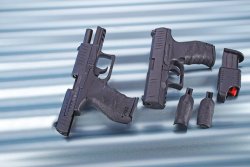
The frame and slide contour have been adopted from the P99 Q. Inside it is simpler than the model for government authorities: The PPQ is Walther’s first large caliber pistol which has to be decocked by pressing on the trigger for disassembly – from a safety point of view a step backwards. But this simplifies the design, saves money – many authorities and military forces don’t seem to be worried by this. The PPQ is disassembled the way that the pistols of their great competitiors from Austria always were.
Just like the P99 Quick Action, the PPQ has a narrow button in the middle of the trigger blade as a trigger safety, similar to the Glock. This reduces the danger of the trigger being accidentally depressed if you don’t have the fingertip completely on the trigger blade. Primarily this safety ensures that the trigger blade doesn’t pull back independently in the case of a heavy blow or jolt. Here the PPQ is delivered as shown. In the USA this version has become known as the PPQ M1 – there there is also an “M2”. This differs from the M1 due to its classical magazine button at the side, it requires its own magazine.
The Fututre
It’s unlikely that Walther won’t continue working hard on the P99 line: in 2013 a prototype of the PPQ with a longer barrel and slides came out . On top of that US fans want a compact PPQ in the style of the P99c. It would be nice if Walther would also offer a compact model of the P99 Q. And in general: the Walther P99 Q is far too good to only be made availble to police officers and soldiers.
Technical Data for the Walther Pistols
| Model: | P99 AS | P99C AS | P99 Q | PPQ | PPX |
| Price: | €
869 | €
869 | – /
–* | €
899 | €
569 |
| Capacity: | 15
+ 1 Rounds | 10
+ 1 Rounds | 15
+ 1 Rounds | 15
+ 1 Rounds | 16
+ 1 Rounds |
| Measurements (mm): | 180
x 34 x 136 | 168
x 34 x 110 | 180
x 34 x 136 | 180
x 34 x 136 | 186
x 34 x 143 |
| Barrel lenght (mm): | 102 | 89 | 102 | 102 | 102 |
| Sight Radius (mm): | 156 | 142 | 156 | 156 | 160 |
| Trigger: | DA/SA | DA/SA | partially cocked | SA | partially cocked |
| Trigger Weight (g): | 4.000 / 2.000 | 4.000 / 2.000 | 2.500 | 3.200 | 2.900 |
| Weight
(g): | 685 | 620 | 690 | 695 | 765 |
| Design: | Anti Stress Trigger, Decocker, Ambidextrous control levers, Steel sights, Picatinny-Rail, Interchangeable backstraps | Anti-Stress Trigger,
Decocker, Ambidextrous control levers Steel sights, Picatinny-Rail, Interchangeable backstraps | Partially cocked, Restrike function, Steel sights with phosphorescent marking, HiGrip gripping surface, Picatinny-Rail *This Model is not available on the civilian market. | Quick
Defence Trigger, Steel sights with phosphorescent marking, HiGrip gripping surface, Picatinny-Rail, Grooves at the front | Hammer
firing lock, Partially cocked trigger, Onesided control levers, Adjustable magazine release, Steel sights |
Test Shooting Walther P99 Q
| No. | Ammunition (grs) | EP(mm) | V2 | E2 | Fakto |
| 1 | 95
grs Magtech JSP | 46 | 394 | 478 | 123 |
| 2 | 120
grs Lapua CEPP | 46
(32) | 353 | 484 | 139 |
| 3 | 123
grs Fiocchi FMJ | 84 | 364 | 528 | 147 |
| 4 | 124
grs Hornady XTP | 42 | 344 | 475 | 140 |
| 5 | 147
grs Magtech JHP | 54
(20) | 287 | 392 | 138 |
Test Shooting Walther PPQ
| No. | Ammunition (grs) | EP(mm) | V2 | E2 | Fakto |
| 1 | 115
grs GECO JHP | 85
(52) | 351 | 459 | 132 |
| 2 | 115
grs PMC Bronze | 88
(67) | 340 | 431 | 128 |
| 3 | 123
grs Fiocchi FMJ | 39 | 341 | 463 | 138 |
| 4 | 124
grs GECO FMJ | 55
(32) | 330 | 438 | 134 |
| 5 | 124
grs TopShot FMJ | 57 | 327 | 430 | 133 |
Test Shooting Walther PPX with 9 mm Luger
| No. | Ammunition (grs) | EP (mm) |
| 1 | 115
grs Sellier & Bellot JHP | 69 |
| 2 | 115
grs GECO JHP | 80
(63) |
| 3 | 115
grs Remington JHP | 84 |
| 4 | 115
grs Magtech JHP | 122
(52) |
| 5 | 120
grs Lapua CEPP Super | 70
(42) |
| 6 | 124
grs Remington Golden Saber | 57
(21) |
| 7 | 124
grs PMC FMJ | 84 |
| 8 | 125
grs Hornady Steel Match JHP | 89 |
| 9 | 140
grs Sellier & Bellot FMJ | 114 |
| 10 | 147
grs Speer Lawman FMJ | 99 |
| 11 | 154
grs GECO FMJ | 176 |
Annotations/Abbreviations: EP(mm) = Error probability in millimeters from 25 meters, groups of five shots, ascertained from a sitting position with loaded sidearm. Values in brackets following the triggering of a stray bullet. JHP = Jacketed Hollow Point. CEPP = Controlled Effect Police Projectile. FMJ = Full Metal Jacket.



